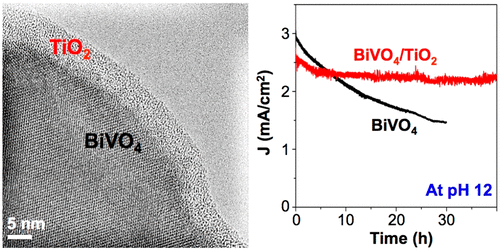当前位置:
X-MOL 学术
›
Chem. Mater.
›
论文详情
Our official English website, www.x-mol.net, welcomes your
feedback! (Note: you will need to create a separate account there.)
Enabling Solar Water Oxidation by BiVO4 Photoanodes in Basic Media
Chemistry of Materials ( IF 7.2 ) Pub Date : 2018-07-06 00:00:00 , DOI: 10.1021/acs.chemmater.8b01405 Dongho Lee , Alexander Kvit , Kyoung-Shin Choi
Chemistry of Materials ( IF 7.2 ) Pub Date : 2018-07-06 00:00:00 , DOI: 10.1021/acs.chemmater.8b01405 Dongho Lee , Alexander Kvit , Kyoung-Shin Choi

|
Titanium dioxide (TiO2) deposited by atomic layer deposition (ALD) has been the most commonly used protection layer to enhance chemical and photoelectrochemical stabilities of photoelectrodes. In this study, we report a new electrochemical deposition method that can place a thin, conformal TiO2 coating layer on a photoelectrode. This method takes <1 min and may serve as a practical alternative to ALD for the deposition of a TiO2 layer. The uniform quality of the TiO2 protection layer was confirmed by demonstrating the chemical stability of the BiVO4/TiO2 electrode in strongly basic media (pH 12 and 13) where BiVO4 readily dissolves. More importantly, the high-quality TiO2 protection layer made it possible to comparatively investigate photoelectrochemical properties and stabilities of the BiVO4 and BiVO4/TiO2 electrodes, which was critical to elucidate the effect that the chemical instability of BiVO4 in basic media has on the rate of photocorrosion. Systematic photoelectrochemical studies for sulfite oxidation and water oxidation provided a coherent understanding of how the interplay among the relative rates of interfacial charge transfer, surface recombination, and photocorrosion affects the photocurrent generation and photostability of BiVO4. On the basis of this understanding, stable photocurrent generation for water oxidation could be achieved at pH 12 over 20 h using a BiVO4/TiO2/FeOOH/NiOOH electrode where FeOOH/NiOOH served as oxygen evolution catalyst. The results and discussion contained in this study provide new insights into the understanding of photocurrent decay caused by photocorrosion involving dissolution, enabling the development of effective strategies to achieve stable photocurrent generation.
中文翻译:

在碱性介质中通过BiVO 4光电阳极实现太阳能氧化
通过原子层沉积(ALD)沉积的二氧化钛(TiO 2)是最常用的保护层,用于增强光电极的化学和光电化学稳定性。在这项研究中,我们报告了一种新的电化学沉积方法,该方法可以在光电极上放置一层薄的,保形的TiO 2涂层。此方法耗时少于1分钟,可以作为ALD的实用替代方法来沉积TiO 2层。的TiO 2的质量均匀2保护层,通过展示BiVO的化学稳定性确认4 /二氧化钛2电极在强碱性介质(pH为12和13)其中,BiVO 4容易溶解。更重要的是,高质量的TiO 2保护层使得可以比较研究BiVO 4和BiVO 4 / TiO 2电极的光电化学性质和稳定性,这对于阐明BiVO 4在基本介质中的化学不稳定性的影响至关重要。具有对光腐蚀的速率。对亚硫酸盐氧化和水氧化的系统光电化学研究提供了对界面电荷转移,表面重组和光腐蚀的相对速率之间的相互作用如何影响BiVO 4的光电流产生和光稳定性的连贯理解。。基于该理解,使用BiVO 4 / TiO 2 / FeOOH / NiOOH电极(其中FeOOH / NiOOH用作析氧催化剂),在pH 12下在20 h内可实现稳定的水氧化光电流产生。这项研究中包含的结果和讨论为理解由涉及溶解的光腐蚀引起的光电流衰减提供了新的见解,从而使开发有效的策略来实现稳定的光电流产生成为可能。
更新日期:2018-07-06
中文翻译:

在碱性介质中通过BiVO 4光电阳极实现太阳能氧化
通过原子层沉积(ALD)沉积的二氧化钛(TiO 2)是最常用的保护层,用于增强光电极的化学和光电化学稳定性。在这项研究中,我们报告了一种新的电化学沉积方法,该方法可以在光电极上放置一层薄的,保形的TiO 2涂层。此方法耗时少于1分钟,可以作为ALD的实用替代方法来沉积TiO 2层。的TiO 2的质量均匀2保护层,通过展示BiVO的化学稳定性确认4 /二氧化钛2电极在强碱性介质(pH为12和13)其中,BiVO 4容易溶解。更重要的是,高质量的TiO 2保护层使得可以比较研究BiVO 4和BiVO 4 / TiO 2电极的光电化学性质和稳定性,这对于阐明BiVO 4在基本介质中的化学不稳定性的影响至关重要。具有对光腐蚀的速率。对亚硫酸盐氧化和水氧化的系统光电化学研究提供了对界面电荷转移,表面重组和光腐蚀的相对速率之间的相互作用如何影响BiVO 4的光电流产生和光稳定性的连贯理解。。基于该理解,使用BiVO 4 / TiO 2 / FeOOH / NiOOH电极(其中FeOOH / NiOOH用作析氧催化剂),在pH 12下在20 h内可实现稳定的水氧化光电流产生。这项研究中包含的结果和讨论为理解由涉及溶解的光腐蚀引起的光电流衰减提供了新的见解,从而使开发有效的策略来实现稳定的光电流产生成为可能。











































 京公网安备 11010802027423号
京公网安备 11010802027423号